☆ PuniPuni Youtube ☆
Japanese Vocabulary: Basic Japanese Adjectives Part 2 – Review Notes
Today we learned some more basic adjectives in Japanese! Let’s go over what we learned today and then we will see a list of some extra Japanese adjectives.
To learn more about the grammar of adjectives, please see our last grammar lesson.
………………………………………………………………………………..
Number 1:
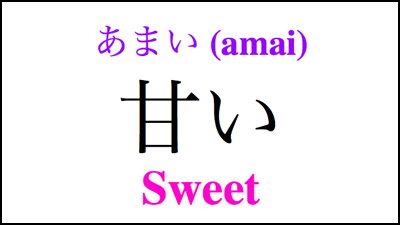
★ 甘い (amai) means sweet in Japanese.
※ When used as an adjective to describe a person,
甘い (amai) does not mean sweet, but naive.

………………………………………………………………………………..
Example 1:
甘いものが好きです。
Amai mono ga suki desu.
I like sweet things.
………………………………………………………………………………..
Example 2:
このケーキは甘いです。
Kono kēki wa amai desu.
This cake is sweet.
………………………………………………………………………………..
Number 2:
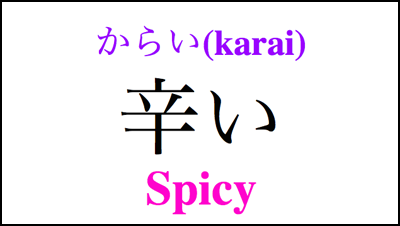
★ Spicy in Japanese is 辛い (karai)!

………………………………………………………………………………..
Example 1:
辛いものは苦手です。
Karai mono wa nigate desu.
I’m not good with spicy things.
………………………………………………………………………………..
Example 2:
このスープは辛いです。
Kono sūpu wa karai desu.
This soup is spicy.
………………………………………………………………………………..
Number 3:

★ The Japanese word for sour is 酸っぱい (suppai).

………………………………………………………………………………..
Example 1:
酸っぱい梅干しが食べたいです。
Suppai umeboshi ga tabetai desu.
I want to eat sour umeboshi.
………………………………………………………………………………..
Example 2:
梅干しは酸っぱいです。
Umeboshi wa suppai desu.
Umeboshi is sour.
………………………………………………………………………………..
Number 4:
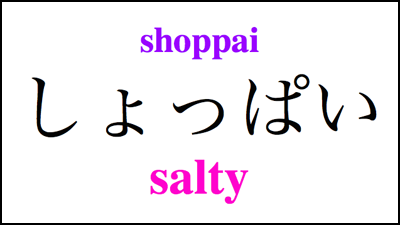
★ The Japanese word for salty is しょっぱい (shoppai).

………………………………………………………………………………..
Example 1:
しょっぱいラーメンを食べました。
Shoppai rāmen o tabemashita.
I ate salty ramen.
………………………………………………………………………………..
Example 2:
このラーメンはしょっぱいです。
Kono rāmen wa shoppai desu.
This ramen is salty.
………………………………………………………………………………..
Number 5:

★ The Japanese word for bitter is 苦い (nigai).
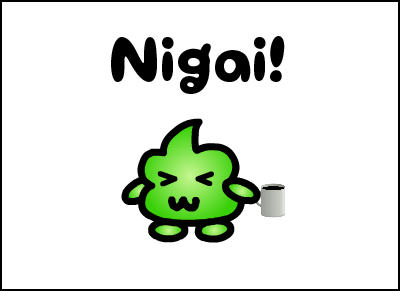
………………………………………………………………………………..
Example 1:
苦いコーヒーがきらいです。
Nigai kōhī ga kirai desu.
I hate bitter coffee.
………………………………………………………………………………..
Example 2:
ブラックコーヒーは苦いです。
burakku kōhī wa nigai desu.
Black coffee is bitter.
………………………………………………………………………………..
Extra Adjective List:
美しい うつくしい utsukushii beautiful
可愛い かわいい kawaii cute
怖い こわい kowai scary
凄い すごい sugoi amazing
素晴らしい すばらしい subarashii fabulous
厳しい きびしい kibishii strict
優しい やさしい yasashii kind
柔らかい やわらかい yawarakai soft
固い かたい katai hard (firm)
緩い ゆるい yurui loose
きつい kitsui tight
おかしい okashii strange
……………………………………………………………………………….
Conclusion:
We learned a lot of Japanese adjectives today! But there are still many more to learn! Check out our other adjective lessons here and here to learn more Japanese adjectives (◕ω◕)♪
If you want to learn more about Japanese adjectives, you might be interested in this book! It includes a list of common adjectives and adverbs and explains in detail about how to use them in a sentence!
……………………………………………………………………………….
………………………………………………………………………………..
………………………………………………………………………………..





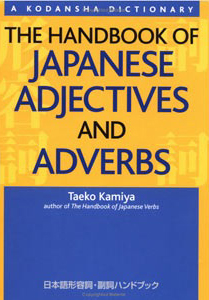




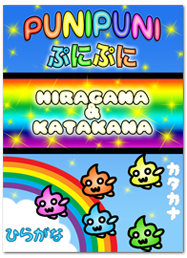



3 comments
This was very helpful, thank you!
Comment by goca on 11/09/2013 at 4:32 pmI often come across「楽しくて」. What does that mean? Can「くて」 be added to any i-adjective? Thank you 🙂
Comment by 花小 on 04/12/2014 at 8:21 pmYes,「くて」can be added to any い-adjective (you replace the final い with くて). This is the て-form of い-adjectives. Just like all verbs in て-form, it doesn’t have meaning by itself. It gets its meaning from the rest of the sentence. For example, you can say 学校は楽しくて面白いです。 (gakkō wa tanoshikute omoshiroi desu) – School is fun and interesting. This use of the て-form is used to connect two adjectives like “and.”
Comment by PuniPuni on 04/12/2014 at 9:03 pm